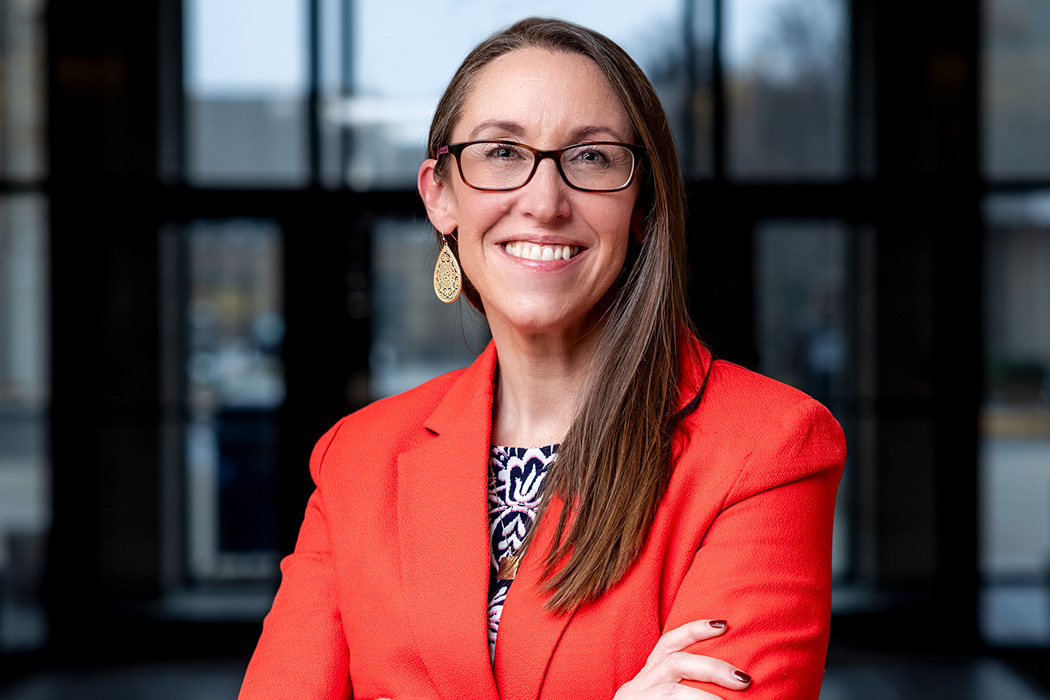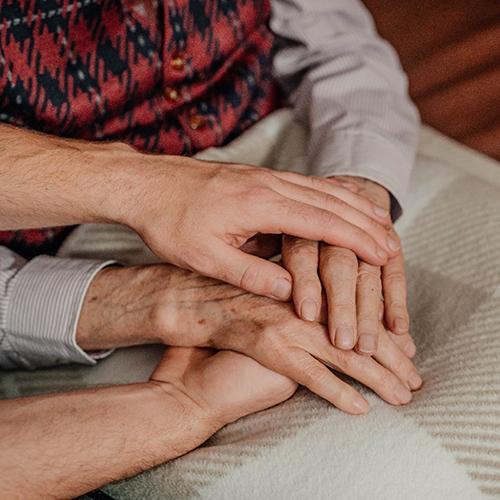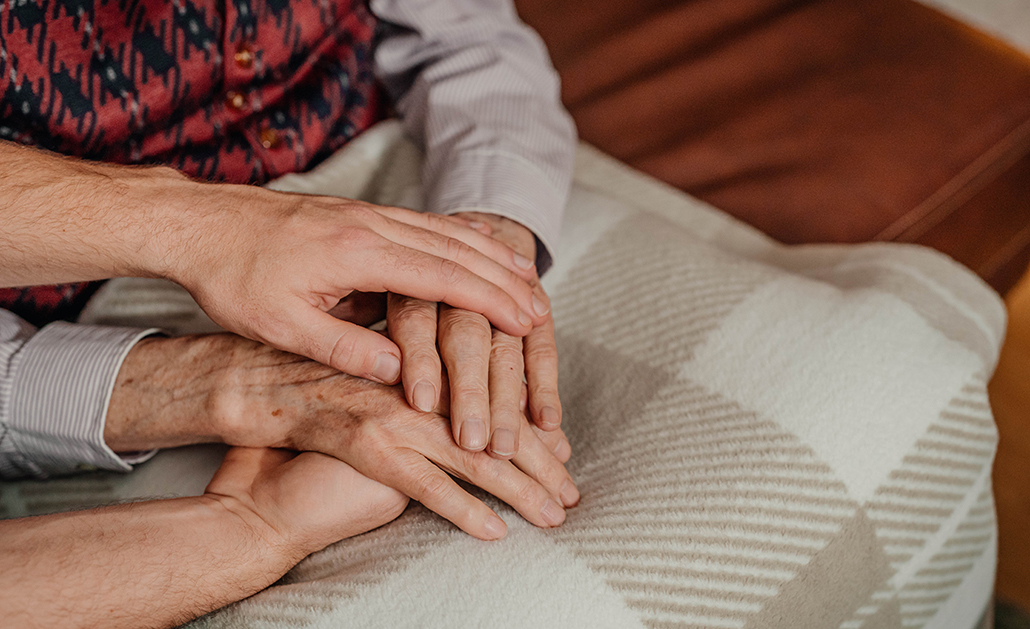
Associate Professor Christina Matz has cultivated a strong relationship with the Spier Family Foundation. Photo by Caitlin Cunningham for BC Photography.
In 2019, Christina Matz, an associate professor at the Boston College School of Social Work, formed a partnership with the Spier Family Foundation, a nonprofit organization dedicated to improving the well-being of the communities in which we work and live.
Matz, chair of the Older Adults & Families Department at BCSSW, knew that the foundation had begun to support projects focused on the health and well-being of people 65 and up. So, she reached out to the organization to see if it would be interested in funding a program for M.S.W. students looking to address the unique challenges facing the nation’s fastest growing segment of the population.
In short order, Matz drafted a grant proposal, the foundation accepted it, and the Spier Fellows in Aging Program was born. The program, now in its sixth year, gives students $3,000 stipends to complete coursework, field placements, and community service projects aimed at helping older adults.
Thanks to funding from the foundation, more than three dozen students have completed internships at hospitals, retirement communities, labs, and other settings dedicated to improving quality of life for a client population that’s often invisible to service providers despite a near ubiquitous presence.
Their accomplishments have included assessing the psychological health of veterans, comforting cancer patients, and working with clients to preserve their independence.
In response to the popularity of the program, Matz teamed up with the Spier Family Foundation again in 2024 to create the Spier Mini-Fellows in Aging Program. The mini fellows in the initial cohort of this program received $1,000 stipends from the foundation to take part in student-led learning opportunities that introduced them to social work careers in aging at the clinical, mezzo, and macro levels of practice.
One student took a training course in life review therapy, interviewed more than 20 residents of Marian Manor Nursing home in South Boston, and then created a book with stories about their lives.
Another student hosted five free events at the Roxbury Public Library for older adults and families, with a particular focus on creating art.
And a third student became a certified death doula.
We asked Matz to reflect on her long-standing collaboration with the Spier Family Foundation, with an emphasis on how she connected with the organization, what the grant application process was like, and why other faculty should build partnerships with non-federal sponsors.
First of all, how did you find out about the Spier Family Foundation?
The Spier Family Foundation had funded a lot of projects in my local community and I had taken notice of them. Around 2017, I came across the foundation’s website and found that they were expanding into the area of aging. The foundation had recently funded some fellowships at Harvard University and Massachusetts General Hospital focused on palliative care, and so I reached out to see if they’d be interested in funding a fellowship program at BC. The foundation was extremely enthusiastic and gave me a ton of flexibility to propose whatever I wanted.
I initially proposed a modest program, which they were excited about, and they actually offered additional funding to support our work. We ran with it and they were really happy with the program’s progress. When we re-applied the following year, they agreed to expand the program, offering even more funding.
How did you use the initial round of funding?
Backed by the support of the Spier Family Foundation, we provided $3,000 stipends to five students who were in their final years of the MSW program and interested in supporting the health and well-being of older adults. The students participated in integrative seminars every month throughout the semester, each of which focused on a different theme around aging. They also hosted integrative seminars at their field agencies, where they gave presentations about the work that they do, really exposing their peers to different settings dedicated to improving quality of life for older adults.
With additional funding in year four, we were able to expand the program from five to 10 students. We also opened it up to first-year students, enabling us to use the fellowship as a recruitment tool for students interested in aging.
We argued that we wanted a cohort model so that students could stay in the program for two years. Students in their first year in the cohort engage in research or community service projects focused on aging, either as groups or as individuals. Over the years, they’ve done some fascinating projects, from hosting educational workshops at BC to bringing in guest speakers.
One fellow designed a quilt to honor the memory of older adults who have positively impacted BCSSW students. Another fellow created a series of information sessions to help increase public awareness of dementia, a condition that will likely affect nearly 13 million Americans by 2050.
This year, first-year students are leading a suicide awareness training focused on older adults and bringing in guest speakers from the Samaritans, a group that works to provide lifesaving suicide prevention services.
The final-year students are hosting the integrative seminars. One student recently hosted a seminar at Somerville-Cambridge Elder Services, a nonprofit dedicated to helping older adults maintain independence.
What’s the status of your partnership with the Spier Family Foundation now?
We’re in the third year of our second grant from the Spier Family Foundation, and we’re currently in talks about the next round of funding.
A few years ago, we had such a great application pool and had to turn down around a dozen students. So I reached out to the foundation and I said, “We had a lot of unbelievable applications and we would love to be able to provide support for students who weren’t able to participate in the formal fellowship.” The foundation asked for new proposals, and I came up with the idea of a mini-fellowship.
We had 10 fellows in the program’s inaugural cohort in 2024, all of whom received $1,000 stipends from the Spier Family Foundation to take part in student-led learning opportunities that introduced them to social work careers in aging at the clinical, mezzo, and macro levels of practice.
One student used the money to participate in an intensive, three-day training program facilitated by the International End-of-Life Doula Association and ended up becoming a certified end-of-life doula.
Another student created a podcast for the Alzheimer’s Association and brought in guest speakers who talked about the cultural responsiveness of working with families caring for loved ones with dementia.
Has this fellowship led to more partnerships with organizations focused on aging?
I think it’s helped to formalize and foster partnerships. Using an honorarium as part of our funding from the Spier Family Foundation, we had Leonora Buitrago, a staff member at the Alzheimer’s Association with a particular focus on outreach to Latinx communities, give a presentation at a seminar. We also took students to Hebrew SeniorLife, New England’s largest nonprofit provider of senior care and living communities, to show them how the nonprofit works with the local housing authority.
Do you have to produce a progress report for the Spier Family Foundation every year?
Yes, but the foundation leaves the specifics up to me. We have a survey that focuses on a variety of competencies in gerontological social work. In particular, we do a pre-test and post-test survey of everybody who goes through the program, and it’s pretty comprehensive. We also ask students about their motivation to apply—was it the stipend, was it the learning opportunities? In addition, right before they graduate, we ask the fellows to name the most impactful component of the program. And we have a couple open-ended questions about their experience, what it’s meant to them, and how it’s shaped their career goals.
What was the most rewarding part of the application process?
Collaborating with mission-driven partners who care deeply about the work—whether it’s with older adults or another population of focus. There’s something energizing about working with people outside of academia who are committed to change and bring practical insight to the table. These kinds of partnerships not only expand the reach and relevance of your work, but also spark new ideas and possibilities for how we train students, design interventions, and engage with communities.
What was the most challenging part of the application process?
Navigating how to frame the work in a way that meets both the community or sponsor’s programmatic priorities and academic goals. It takes creativity to position implementation, practice-based, or translational research as a natural fit for programmatic funding. But these opportunities can be incredibly rich—they allow you to do rigorous academic work that’s also grounded in real-world impact. Being flexible in how you design and describe your project is key to making it work for both audiences.
What advice would you give other faculty members who are looking to build partnerships with non-federal sponsors?
Start by listening and learning. Non-federal sponsors—whether foundations, local agencies, or national nonprofits—often have clearly defined missions and are deeply connected to the populations they serve. Strong partnerships are built on shared goals, trust, and mutual benefit, so it’s essential to approach these relationships with humility and flexibility. Be open to co-creating ideas rather than coming in with a fully formed academic agenda. And remember, the most meaningful partnerships often grow out of local or grassroots connections that may not show up on your radar through traditional funding channels.



